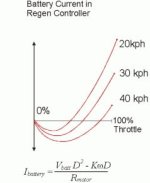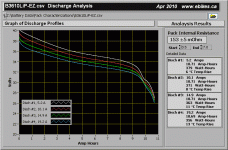justin_le said:
mrbill said:
For some reason when I watched the diagnostic screen, it would always lock in a little over 3 seconds. Maybe my finger isn't steady unless I'm paying attention.
I think that must be the case. I did most of my testing with a twist throttle rather than a thumb throttle, and found even at 0.05V I could get it reliably to lock. I've been thinking about ways to have a little 'count down' timer as you hold the throttle so that you'd be able to know where it's at.
In general it seems that the cruise control has trouble locking when the actual "Speed" or "Power" is varying significantly, even if the throttle voltage is being held within a tight range for the required lock time.
That's interesting and it must be that the variations in power of the ebike are causing you to shift your throttle position slightly, just enough to release the cruise latch counter. It sounds like I might want to increase the upper bounds, to like +-0.4V rather than +-0.25V. In theory the whole cruise timing and latch process is completely independent of the throttle mode selected.
The problem may be that it locks within 0.05V no matter the setting of the threshold voltage. Here is a video I took showing the threshold voltage set to 0.25V. Then when I attempt to set the cruise control while purposely varying the input
within the 0.25V threshold, the cruise can be seen attempting to lock (as seen by the flashing "In") but then losing lock a second later or when the throttle is released.
[youtube]zLsWxHtUfVg[/youtube]
Is it possible that my throttle variations are causing voltage peaks wider than the threshold voltage that do not show on the CA? I set the Averaging to "3" to see quicker changes on the display in this video.
I can see myself using power throttle with a lower maximum limit when I'm riding with non-ebikers, perhaps using an alternate preset.
It was nice to up-shift to a taller gear and have the controller instantly ramp back the throttle to maintain the set power. And, it was also nice when reaching the top of a rise to have the motor continue to apply constant power as the RPMs increased. On the other hand, I miss the "press me back into my seat"--I ride a recumbent--feel that occurs with a voltage-based cruise control when the road heads up.
Yeah, that well describes the experience of different throttle control strategies. For auto-cruise control, I would think that the pass-thru throttle would generally be the most appropriate since the idea is usually to preserve your speed. And then if you want variable power levels for the sake of stretching the battery life or riding along pedal bikes, then set the Aux Input to control your power limit with a switch or potentiometer.
My idea here is to fix the power at a certain level, say, when riding over terrain of varying grade with other cyclists in close formation without having to make frequent small throttle or cruise adjustments. The power level would be usually somewhere around 250-400 watts (in). The human-powered cyclists generally ride power-limited, so the power-based cruise ought to be able to match their profile better than a voltage throttle over varying terrain. Your idea of using a preset with a lower power limit, e.g. 500 or 600 watts, would make it easier to settle on the correct power level without overshooting. I'll have to test this the next time I go riding with others.
I know that using standard voltage throttle with cruise, I tend to pull away as the grade increases and tend to get caught up to as the grade decreases (if I was climbing the steeper terrain at human-powered speed). So, on varying terrain I have to make continuous adjustments with the throttle or by varying human effort, if I can.
Throttle up-ramp and fast up-ramp seems to work only in "Speed" and "Power" throttle modes. (I assume it also works in "Current" throttle, although I didn't test this, figuring the behavior was almost the same as "Power" throttle as I use LiFe batteries that have good regulation.)
The output ramps apply equally the same regardless of your input throttle mode. So I think that you are confusing delays associated with the speed and power feedback loops (IntSGain, WGain resepectively) with the actual throttle ramp limiting. It's a little complicated with so many different parameters all having their affect on the throttle output, but the throttle output ramps are applied across the board to the output signal, and nothing can over-ride that and make it change faster (except the ebrake, which causes an abrupt drop to 0V).
In "Pass-Thru" mode the throttle operates without delay as if it's connected to the controller (although subject to the limits, speed, current, power, temperature, etc., set elsewhere). Most of the time I think I prefer this, but it would be nice to have the option of up-ramp, down-ramp, and fast up-ramp available in Pass-Thru mode.
Just to be clear, the throttle ramps equally apply in pass thru throttle mode as well. Can you tell me what values of the throttle ramp in Sec/Volt you were using? You should be able to go to the diagnostic screen and see VOut climb up and down at the same rate as your ramp setting.
After putting the bike on the trainer to create an artificial load I confirmed that you are correct. The throttle Out parameters, upRamp and fastRamp, do have an effect in Pass-Thru mode. Perhaps in Power mode the ramp behavior is more obvious because a small throw of the lever generally results in higher power than in Pass-Thru mode. Or, as you suggested, I am really noticing the effect of S or W gain in those modes since these limits are usually binding in their respective throttle modes.
On my ride I used the following settings:
ThrO Pass-Thru
ThrO upRamp - 0.30 sec/Volt
ThrO fastRamp - 0.05 sec/Volt
SLim IntSGain - 100
SLim PSGain - 100V/min
SLim DSGain - 100
PLim AGain - 100
PLim WGain - 50
In the videos I changed Thro upRamp to 1.30 sec/Volt so that I could more easily observe its effect.
I was hoping to be able to find a combination of ThrO upRamp and fastRamp that would maintain good throttle response--not too slow or delayed--but would also reduce drivetrain "slam" when introducing motor power. But I haven't been able to find a combination that doesn't add an irritating delay of the sort one used to see on early-1970s GM carbureted engines that often had an annoying hesitation after pressing the gas pedal.
The video below demonstrates a few instances (starting at about halfway through) of cruising under power and dropping out motor power, only to reintroduce it while the drivetrain is still in motion. The point at which motor power is re-introduced to the system one can briefly see over 20-30 Amps on the CA display--watch carefully or you'll miss it--at the moment one hears the "slam". It's this high peak I'm trying to soften without introducing too much delay in throttle response. Is this achievable?
[youtube]sSdDVr9q6Fc[/youtube]
Can the 2 Amp threshold for fastRamp->upRamp transition be set by the user? I think I'd choose 3 Amps on my system as the full-throttle freespin current on my motor is between 2 and 3 Amps.




